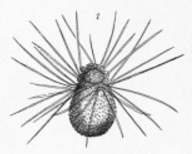SAR supergroup




SAR supergroup is a major clade in the eukaryotic domain, encompassing a diverse array of organisms. The name "SAR" stands for Stramenopiles, Alveolata, and Rhizaria, which are the three major groups included within this supergroup. The SAR supergroup is recognized for its significant role in both ecological systems and human affairs, particularly through members that are involved in primary production, disease, and as part of the food web.
Classification and Characteristics[edit]
The SAR supergroup is a result of molecular phylogenetic studies, which have reshaped our understanding of eukaryotic evolution. These studies have shown that the members of the SAR supergroup share a common ancestor, diverging from other eukaryotes early in the evolutionary history.
Stramenopiles[edit]
Stramenopiles, also known as Heterokonts, are characterized by their unique flagellar structure, with one smooth flagellum and one hairy flagellum. This group includes a wide range of organisms, from algae like diatoms and brown algae, to oomycetes, which are fungus-like organisms.
Alveolata[edit]
Alveolata are defined by the presence of cortical alveoli, small vesicles located beneath the cell membrane, believed to be involved in supporting the cell surface. This group includes dinoflagellates, apicomplexans, and ciliates. Apicomplexans are particularly notable for including species that cause serious diseases in humans, such as malaria (caused by Plasmodium spp.).
Rhizaria[edit]
Rhizaria is a diverse group that includes organisms with complex shell-like structures, such as foraminifera and radiolarians. These organisms are mostly amoeboid, with long, thin pseudopods that are used for feeding and mobility.
Ecological and Economic Importance[edit]
The SAR supergroup encompasses organisms that play crucial roles in global ecosystems. For example, diatoms and other photosynthetic stramenopiles are major contributors to marine primary production, forming the base of the oceanic food web. On the other hand, some members of the Alveolata and Rhizaria are important in the context of human health and disease, as well as in the fossil record for understanding past environmental conditions.
Research and Future Directions[edit]
Research into the SAR supergroup continues to uncover the vast diversity and complexity of these organisms. Understanding the evolutionary relationships within the SAR supergroup is critical for reconstructing the tree of life and for understanding the evolution of complex cellular structures and life cycles. Additionally, studying these organisms can provide insights into their roles in ecosystems, their potential biotechnological applications, and their impacts on human health.

Ad. Transform your life with W8MD's Budget GLP-1 injections from $75


W8MD offers a medical weight loss program to lose weight in Philadelphia. Our physician-supervised medical weight loss provides:
- Weight loss injections in NYC (generic and brand names):
- Zepbound / Mounjaro, Wegovy / Ozempic, Saxenda
- Most insurances accepted or discounted self-pay rates. We will obtain insurance prior authorizations if needed.
- Generic GLP1 weight loss injections from $75 for the starting dose.
- Also offer prescription weight loss medications including Phentermine, Qsymia, Diethylpropion, Contrave etc.
NYC weight loss doctor appointmentsNYC weight loss doctor appointments
Start your NYC weight loss journey today at our NYC medical weight loss and Philadelphia medical weight loss clinics.
- Call 718-946-5500 to lose weight in NYC or for medical weight loss in Philadelphia 215-676-2334.
- Tags:NYC medical weight loss, Philadelphia lose weight Zepbound NYC, Budget GLP1 weight loss injections, Wegovy Philadelphia, Wegovy NYC, Philadelphia medical weight loss, Brookly weight loss and Wegovy NYC
|
WikiMD's Wellness Encyclopedia |
| Let Food Be Thy Medicine Medicine Thy Food - Hippocrates |
Medical Disclaimer: WikiMD is not a substitute for professional medical advice. The information on WikiMD is provided as an information resource only, may be incorrect, outdated or misleading, and is not to be used or relied on for any diagnostic or treatment purposes. Please consult your health care provider before making any healthcare decisions or for guidance about a specific medical condition. WikiMD expressly disclaims responsibility, and shall have no liability, for any damages, loss, injury, or liability whatsoever suffered as a result of your reliance on the information contained in this site. By visiting this site you agree to the foregoing terms and conditions, which may from time to time be changed or supplemented by WikiMD. If you do not agree to the foregoing terms and conditions, you should not enter or use this site. See full disclaimer.
Credits:Most images are courtesy of Wikimedia commons, and templates, categories Wikipedia, licensed under CC BY SA or similar.
Translate this page: - East Asian
中文,
日本,
한국어,
South Asian
हिन्दी,
தமிழ்,
తెలుగు,
Urdu,
ಕನ್ನಡ,
Southeast Asian
Indonesian,
Vietnamese,
Thai,
မြန်မာဘာသာ,
বাংলা
European
español,
Deutsch,
français,
Greek,
português do Brasil,
polski,
română,
русский,
Nederlands,
norsk,
svenska,
suomi,
Italian
Middle Eastern & African
عربى,
Turkish,
Persian,
Hebrew,
Afrikaans,
isiZulu,
Kiswahili,
Other
Bulgarian,
Hungarian,
Czech,
Swedish,
മലയാളം,
मराठी,
ਪੰਜਾਬੀ,
ગુજરાતી,
Portuguese,
Ukrainian